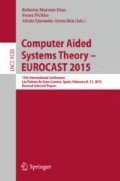Abstract
The contribution of this paper is to present a results of applications of set theory and relations in modeling a complex distributed systems, based on parallel computing platform. The advantages of using the set theory are: the possibility of a formal examination of the local problems, and the possibility to organize individuals as elements of the considered classes, defined globally. To govern the collective behavior we propose three key relations and mappings determined taxonomic order on them. That can insulate us from reductionism and single-cause thinking, as people deal with complexity before. On three examples, we show how take advantage of the new parallel programming tools to obtain more effective multiple inputs in parallel way, than assigning sequentially single causes for any outputs.
Access this chapter
Tax calculation will be finalised at checkout
Purchases are for personal use only
References
Arsene, C., Bargiela, A., Al-Dabass, D.: Simulation of network systems based on loop flows algorithms. Int. J. Simul. Syst. Sci. Technol. 5(1–2), 61–72 (2004)
Box, G.E.P., Draper, N.R.: Empirical Model Building and Response Surfaces. Wiley, New York (1987)
Corning P.A.: Synergy and self-organization in the evolution of complex systems. Syst. Res. 12(2), 89–121 (1995). doi:10.1002/sres.3850120204 (Wiley)
Kuratowski, K., Mostowski, M.: Set Theory, with introduction to descriptive set theory. In: Studies in Logic and the Foundations of Mathematics, vol. 86. PWN-Warsaw, North- Holland- Amsterdam, New York, Oxford (1976)
Lloyd, S.: Measures of complexity: a nonexhaustive list. IEEE Control Sys. Mag. 21(4), 7–8 (2001). doi:10.1109/MCS.2001.939938
Marques, J., Cunha, M.C., Sousa, J., Savic, D.: Robust optimization methodologies for water supply systems design. Drinking Water Eng. Sci. 5(1), 31–37 (2012). doi:10.5194/dwes-5-31-2012
Nikodem, J., Klempous, R.: Smart water distribution system, cloud computing. In: ICIT 2013, The 6th International Conference on Information Technology, Amman/Jordan, Al-Dahoud. Al-Zaytoonah University of Jordan, Amman (2013)
Nikodem, J.: Modelling of collective animal behavior using relations and set theory. In: Moreno-Díaz, R., Pichler, F., Quesada-Arencibia, A. (eds.) EUROCAST. LNCS, vol. 8111, pp. 110–117. Springer, Heidelberg (2013)
Seiffertt, J., Wunsch, D.C.: Introduction. In: Seiffertt, J., Wunsch, D.C. (eds.) Unified Computational Intell. for Complex Sys. ALO, vol. 6, pp. 1–17. Springer, Heidelberg (2010)
Parrish, J.K., Viscido, S.V., Grunbaum, D.: Selforganized fish schools: an examination of emergent properties. Biol. Bull. 202, 296–305 (2002)
Reynolds, C.W.: Flocks, herds, and schools: a distributed behavioral model. In SIGGRAPH 1987 Conference Proceedings, Computer Graphics, vol. 21, no. 4, pp. 25–34 (1987)
Siew, C., Tanyimboh, T.: Augmented gradient method for head dependent modeling of water distribution networks. World Environmental and Water Resources Congress (2009). doi:10.1061/9780784410363
Speakman, J.R., Banks, D.: The function of flight formations in Greylag Geese Anser anser; energy saving or orientation? Department of Zoology, University of Aberdeen, Aberdeen AB24 2TZ. Scotland, UK, IBIS 140(2), 280–287 (1998). doi:10.1111/j.1474-919X.1998.tb04390.x
Sumpter, D.J.T.: The principles of collective animal behaviour. Phil. Trans. R. Soc. B 361, 5–22 (2006). doi:10.1098/rstb.2005.1733
Author information
Authors and Affiliations
Corresponding author
Editor information
Editors and Affiliations
Rights and permissions
Copyright information
© 2015 Springer International Publishing Switzerland
About this paper
Cite this paper
Nikodem, J. (2015). Structuring the Model of Complex System Using Parallel Computing Techniques. In: Moreno-Díaz, R., Pichler, F., Quesada-Arencibia, A. (eds) Computer Aided Systems Theory – EUROCAST 2015. EUROCAST 2015. Lecture Notes in Computer Science(), vol 9520. Springer, Cham. https://doi.org/10.1007/978-3-319-27340-2_16
Download citation
DOI: https://doi.org/10.1007/978-3-319-27340-2_16
Published:
Publisher Name: Springer, Cham
Print ISBN: 978-3-319-27339-6
Online ISBN: 978-3-319-27340-2
eBook Packages: Computer ScienceComputer Science (R0)

